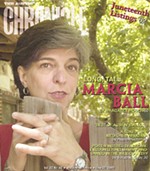Let's 'Rumbo'! Right Now!
New Spanish dailies battle for a young Latino audience looking for news
By Belinda Acosta, Fri., Feb. 25, 2005

Those who watch newspaper publishing call Meximerica Media's Rumbo a big gamble. Not that Antonio Ruiz Camacho has noticed – the managing editor of the new Rumbo de Austin is too busy assembling a newspaper five days a week to worry about naysayers. And it's not as though plenty of other print media haven't launched and failed before. What has drawn observers (and skeptics) to watch Rumbo is its intended readership: first- and second-generation native Spanish speakers, ages 21-54, in communities where Hispanic immigration is large and growing.
Currently, there are four Rumbo newspapers, all in Texas. Edward Schumacher Matos, a former Wall Street Journal editor and CEO and editorial director of Meximerica Media, conceived Rumbo, a full color, tabloid-size publication that features the local news of each base city, in addition to news and features from Mexico and Latin America. (Rumbo – pronounced ROOM-bo – means "heading to" or "on the way," but is also a play on the vernacular phrase rumbo el norte, which means "heading to the U.S." or, metaphorically, to a better life.) Madrid's Recoletos Grupo de Comunicación acquired Meximerica in 2004, but Meximerica remains based in San Antonio, home of Rumbo's first incarnation, launched last July. Rumbo de Houston followed a month later, Rumbo del Valle in October, and finally, Rumbo de Austin began publication on Nov. 22. The chain hopes to move into other U.S. markets in 2005.

Prior to joining Rumbo, Ruiz Camacho, a native of Spain, worked as an editor and reporter for Mexico's Reforma and El Financiero in Madrid, and was editor-in-chief for a Latin American news Web site that eventually went bust. After that experience, you'd think Ruiz Camacho might be less willing to embark on another "risky" venture. But he says the risk is negligible compared to the chance to work on a groundbreaking venture. "This is a project [Schumacher] had in mind for many, many years," says Ruiz Camacho. "He carefully researched various markets before deciding on a Texas launch."
The reasons for beginning in Texas are apparent. The state has a large (and growing) Hispanic population, and of the four cities where Rumbo appears, Austin has seen the largest and fastest growth. According to 2000 U.S. Census figures, the Hispanic population in the Austin metro area was 350,000. Of this number, 73%, according to PRNewswire.com, "prefer to speak Spanish at home." Among Hispanic adults, "75% are first generation immigrants whose first and strongest language is Spanish."
By most estimates, 80% of Texas Hispanics are of Mexican origin. However, Puerto Ricans, Dominicans, Cubans, Salvadorans, and Guatemalans now call Austin home, too, thanks in part to the University of Texas, but also to the turbulent economic and political conditions in various parts of Latin America. This broadly defined population represents some challenges (e.g., not all Latinos are the same, linguistically, culturally, or socially), but it's a challenge Ruiz Camacho believes his staff is well-suited to address. "Our staff is among the most well trained, and come from all over Latin America," Ruiz Camacho says. "An American company owns the paper, but our writers' Latin American background is what we use to reach our readers."
"Not a Ghetto Newspaper"

There are also more generic media uncertainties. Overall newspaper readership is down, and prognosticators are sounding the death knell for newspapers and other print publications. So how is it that not one, but as it turns out, two Spanish language newspapers launched in Austin last year? The answer is not so mysterious, according to Omar Gallaga, editor of ¡ahora sí! ("right now!") the new Spanish-language weekly launched by the Austin American-Statesman on Aug. 19. The paper also hopes to reach the Spanish-speaking audience aged 21-54. "The market research was there to support the need," Gallaga says, "and our advertisers requested it."
As a personal bonus, the longtime Statesman staffer says that in spite of the long hours and shoestring staff, working on ¡ahora sí! has been professionally satisfying. "Before the first issue even came out, I was surprised with how much we were embraced," Gallaga says. As a former film reviewer and entertainment editor, Gallaga finds the response heartening.
"You know, writing a movie review doesn't change people's lives. It's rare in the newspaper business that you get to do something totally new and have an effect immediately. Education, health, family issues – those stories are the stories readers respond to; they get emotionally involved and express that in the letters we get," Gallaga says. "We want to do more community outreach, more community forums to gauge what our readers need and want. We're not trying to be a big city newspaper. In scope and readability, we're for the general reader."

While Ruiz Camacho also promises a commitment to the unique needs of Spanish-speaking and immigrant communities, he does see some differences between Rumbo de Austin and ¡ahora sí! "We are very different animals. We are also very service-focused. We report on important community issues, but always keep in mind the information that impacts our readers' lives. But we also believe the Spanish-speaking population deserves a paper as good as the English language papers. We want to be as good as The New York Times or the Los Angeles Times, The Wall Street Journal or the Austin American-Statesman, but we also want to be an Austin newspaper. We are not a ghetto newspaper. We try to outreach to all of Austin's Hispanic communities, not just on the Eastside, but throughout greater Austin."
Under the Volcano
Although Rumbo and ¡ahora sí! arrive with a great deal of corporate fanfare, Spanish language or bilingual newspapers are not new to Austin. La Prensa, "Austin's oldest bilingual newspaper," founded in 1986, is about 30/70 English and Spanish. Arriba launched around the same time and shared the same goal – promising to cover stories and subjects from the local Mexican-American and Chicano communities that mainstream newspapers like the Statesman and the Chronicle had neglected. Launched in 1990, El Mundo is published weekly entirely in Spanish, as is El Norte. Unlike their splashy new neighbors, all are small, locally owned businesses. Because of that context, Catherine Vasquez Revilla, publisher of La Prensa, is frankly skeptical of the prospects of Rumbo and ¡ahora sí!
"They're great-looking papers, but who can read them?" asks Vasquez Revilla. "The thing that upsets me is that small, locally owned papers like La Prensa, Arriba, and El Mundo – which has done the best job of reaching that limited market that needs to know when the color of the green card changes – now has to compete with these newspapers with plenty of money muscle behind them." (Pearson PLC is currently the principal stakeholder of Meximerica Media; Cox Newspapers owns the Statesman among many other media enterprises).

But even setting aside the uneven financial battle between established smaller papers and deep-pocketed competitors, Vasquez Revilla wonders if there are other long-term cultural limitations on publications aimed expressly at Spanish-only readers. "The immigrant newcomers may be Spanish-dominant when they come here, but the immigrant child immediately gets immersed in an English-only environment. Bilingual education serves a small percentage of the population, and bilingual education funds are not protected," she says. "And post-9/11, immigration is diminishing, not growing. So where's their 'growing' market?" she asks.
Still, Vasquez Revilla has a wait-and-see attitude, because she does not feel La Prensa is threatened in content. "The general newspapers don't cover our issues, and certainly not from our perspective. At any rate, I'm committed to community publishing for as long as possible."
Vasquez Revilla's colleague in community publishing, Roberto Angulo – founder, publisher, and editor of El Mundo – is less conciliatory. In an open letter to the public originally published in El Mundo and translated into English for publication in La Prensa last July 29, Angulo had this to say about the Statesman's foray into Spanish-language newspaper publishing: "Not satisfied with their present image, the Austin American-Statesman is beginning to don thick make-up and strut through our community. ... [E]ven the name of the new periodical indicates a certain lack of esteem and respect for our Latino community. The simple fact of naming the publication 'Ahora Sí' sadly suggests that, though they are now choosing to say 'yes' to our community, this is in contrast to their previous stance of 'Antes No.' ... Well before the eyes of the Austin American-Statesman were turned our way, we were at the heart of our community. So, why would they say 'yes' now, Ahora Sí? The answer is quite simple. The Hispanic market in Central Texas has grown into a beautiful lady, ready to be courted now by countless gentlemen. But where were all those gentlemen only a few years ago, when we were young? Where were they when our community had no voice? Where were they when we had no economic or political support?"

It's unclear how many heard Angulo's pointed question. Unlike the eye-popping crimson coin boxes used by ¡ahora sí! and Rumbo (the former is free; the latter costs 25 cents) and now perched at many bus stops and Downtown street corners, El Mundo, Arriba, La Prensa, and El Norte are harder to come by. Mexican restaurants and the almost equally ubiquitous HEB carry the papers, though not always consistently nor necessarily in a prominent location. They're not always easy to find, at least in this reporter's normal haunts – but that may not be a problem for their intended, neighborhood-based audiences. (For a reader's notes on the range of publications, see "Newsprint in Spanish.")
"A Different Ball Game"
Rosental Alves is the director of the UT-based Knight Center for Journalism in the Americas. Though he admits to not knowing much about Austin's community-based media, he has been following the emergence of Rumbo and other newspapers like it, here and elsewhere. "This is actually a national phenomena, two or three years old in the making. What's happening in Austin is the tip of the iceberg," Alves says. Many of the big U.S. newspaper corporations – Belo, Knight Ridder, Tribune Company, and others, which own papers in Dallas, New York, Miami, Chicago, and New York – have either created their own Spanish-language papers or acquired existing ones, and in some cases, turned them from weekly to daily publications. Miami's El Nuevo Herald, and the Tribune-owned Hoy – a chain that began in New York – are a couple of examples. In Dallas, when Belo acquired Al Dia it effectively forced the Fort Worth Star-Telegram to change its existing Diario La Estrella weekly into a daily, investing more money and resources in order to compete, according to Alves.
In Texas alone, partly in response to Rumbo's strong arrival (according to Simon Romero's Jan. 31 New York Times article on the subject), several new Spanish-language newspapers have either been acquired or launched from scratch as "pre-emptive attacks ... to compete with Rumbo's tabloids." La Frontera and El Nuevo Heraldo now join their English language siblings The Brownsville Herald and McAllen's The Monitor, all Freedom Communications publications (a curiously libertarian chain in the largely Democratic Valley). La Voz and a Spanish entertainment newspaper La Vibra have joined sister publication the Houston Chronicle, all published by Hearst. Closer to home (and also Hearst-owned), the San Antonio Express-News launched the bilingual Conexión. In addition to ¡ahora sí!, Cox Newspapers acquired La Palma in West Palm Beach, Fla., and Mundo Hispanico in Atlanta. The trend does not appear to be diminishing, especially if the U.S. Latino population continues to grow.

"I think it's a different ball game in terms of journalistic quality and investment, of course," Alves says. "But in the case of Rumbo, it's a different understanding of what the present and future of Spanish is in the country. But it's not just language, it's also content. Many people who watch TV in Spanish speak English better than Spanish, but watch TV in Spanish because it's relevant [to them]. I think the same is going on with a project like Rumbo. I think those small or family newspapers have a real threat and an opportunity. The threat comes from the very strong competition. The opportunity comes from having been here a long time. [Community] newspapers know the community, and so there's room for obvious growth on their part," Alves says.
So, if media prognosticators are saying that English-language newspaper readership is falling, does the emergence of Spanish-language newspapers mean Spanish readers are more prevalent? Not necessarily, Alves says. "It's a combination of look, content, and price," he says. Young readers accustomed to reading, for example, The New York Times on the Web at no cost make reluctant newspaper subscribers, so free distribution or only a nominal fee helps to attract them. Providing information that is fun and informative, and which directly impacts readers' lives, is another strong factor. Finally, he suggests, an aesthetically pleasing publication attracts readers of all ages.
"It's very much an industry that's evolving. We're not sure where we're going to end up, but this appeal to Spanish-language readers is one attempt to grow readership overall. Who knows if it will be successful, but it's a really exciting experiment," says Maggie Rivas-Rodriguez, associate professor in the Department of Journalism at UT, adding that the symbolism cannot be underestimated. "It sends a message to the Hispanic community that it's valued."
Whether ¡ahora sí! or Rumbo are seen as posers "donning thick makeup [to] strut through our communities," as Angulo says, or embraced as a valuable resource, it's clear that Spanish-language newspapers are blossoming – whether as perennials or annuals, hot-house delicacies or robust weeds, the answer is not yet clear. What is clear is that there is plenty of fertile ground for those willing to seriously stake their claims. ![]()
*Oops! The following correction ran in our March 4, 2005 issue: In last week's "Let's 'Rumbo'! Right Now!" we incorrectly reported that Rumbo Managing Editor Antonio Ruiz Camacho is a native of Spain. In fact, he is a native of Mexico. The Chronicle regrets the error.
Got something to say on the subject? Send a letter to the editor.










